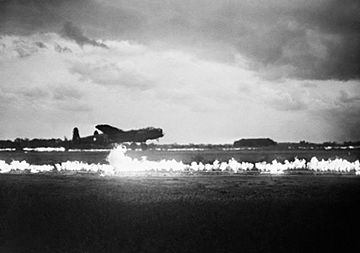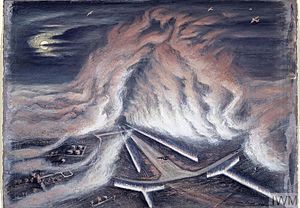Fog Investigation and Dispersal Operation facts for kids
FIDO stands for Fog Investigation and Dispersal Operation. It was a special system used during World War II to clear away thick fog from airfields. This allowed aircraft, especially bombers returning from missions, to land safely even when the weather was very bad.
FIDO was developed in the United Kingdom by Arthur Hartley and others at the University of Birmingham. It was a huge help for the Royal Air Force (RAF) because it saved many planes and the lives of their crews. Before FIDO, landing in heavy fog was extremely dangerous.
How FIDO Worked
The FIDO system used long pipes placed along both sides of a runway. These pipes had many small jets. Fuel, usually aviation gasoline from the airfield's own supply, was pumped through these pipes and out of the jets.
When the system was needed, the fuel was lit, creating long walls of flame. These flames produced a lot of heat. This heat made the tiny fog droplets in the air evaporate, clearing a path directly over the runway. This way, pilots could see the ground and land their planes safely.
The fuel was stored in large tanks near the airfield. These tanks were often protected by brick walls in case of attacks. To light the flames, a Jeep with a flaming torch attached would drive quickly down both sides of the runway. Sometimes, people on bicycles or even runners on foot would light the burners.
Once a plane landed, it would be moved away from the runway. The next day, the planes would be repaired if needed, refueled, and flown back to their home bases.
Why FIDO Was Needed
Before FIDO, fog was a big problem for aircraft returning from missions. Sometimes, large parts of the United Kingdom would be covered in thick fog at the same time. If pilots couldn't land, they were often told to fly their aircraft towards the sea. Then, while still over land, the crew would have to parachute out, leaving the plane to crash into the sea.
Imagine hundreds of planes returning from a mission. Losing many of them and their crews just because of fog was a huge problem. FIDO helped to prevent these losses, making it much safer for aircrews.
Testing FIDO
The first tests of FIDO happened in November 1942. An experimental system successfully cleared 200 yards of thick fog to a height of 80 feet.
The first full-sized FIDO system was set up in January 1943. An aircraft successfully landed between the flames, even though there wasn't any fog at the time.
The first real flights in fog using FIDO happened on July 17, 1943. An Airspeed Oxford plane from No. 35 Squadron RAF made three successful landings and take-offs in dense fog.
FIDO in Action
FIDO used a lot of fuel. Some airfields used as much as 100,000 gallons of fuel per hour! Airfields with longer runways, like RAF Carnaby, used even more. Even though it cost a lot in fuel, everyone agreed that FIDO was worth it. It saved many valuable aircraft and the lives of their crews.
FIDO systems were used at many RAF airfields in England during World War II.
After the war, FIDO was still kept ready for emergencies at RAF Manston until 1952. However, because it was so expensive to run, its use had to be approved by the Air Minister.
FIDO systems were also installed at airfields in North America, including Arcata-Eureka Airport in California, and Naval Air Station Whidbey Island in Washington (state). It was also used at the Amchitka Army Airfield on Amchitka Island in the Aleutian Islands.
Some of the RAF airfields that used FIDO included:
- RAF Blackbushe
- RAF Bradwell Bay
- RAF Carnaby
- RAF Downham Market
- RAF Fiskerton
- RAF Foulsham
- RAF Graveley
- RAF Manston
- RAF Woodbridge
Images for kids





